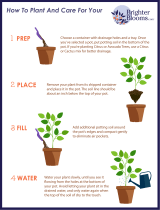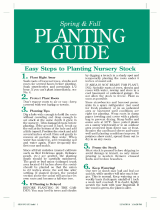Sweet Berry Selections GOBAQT User manual
- Type
- User manual

Planting and Care of Goji Berry Plants
Goji berries are often referred to as the “Superfruit” and are known for their high levels of
vitamins and minerals. Goji berries are very hardy and can easily be grown in your garden or as
a shrub in the landscape. With proper winter protection, plants can also be grown in containers
as patio plants. In fall and winter, plants are shipped dormant and will soon grow new leaves in
spring outdoors or in several weeks if grown indoors.
Growing Goji Berries in the Garden or Landscape
Site Selection
Goji berry plants are very hardy and easy to grow. Young plants can be planted directly into the
landscape or planted in the garden or pot for one to two years then moved to the permanent
location. Plants thrive in full sun in moist well-drained soil with a pH of 6.8 to 8.0. In hot sunny
climates, plant in sites that provide afternoon shade.
Soil Preparation
Goji berry plants prefer alkaline soils. In areas with acid soil, add lime to the soil to increase the
soil pH to between 6.5 – 8.0. Follow the instructions on the garden lime label for the correct
amount of lime to apply to the soil.
Planting
Your Goji berry plants are ready to plant directly into the garden or landscape. Plant a
minimum of five feet apart. Dig a hole large enough to accommodate the root system. Remove
the pot; lightly roughen the root system to spread the surface roots. Place the root system in
the hole and adjust the planting depth to be the same as the top of the pot. Backfill the soil
and firm the soil around the root system. Water thoroughly after planting. It is helpful to apply
a surface mulch of bark mulch, sawdust or other material 2 to 4 inches deep around the plant
to help maintain uniform soil moisture and good soil structure. Water twice weekly until the
plants are established and then water as needed. Goji berry plants are relatively drought
tolerant and are easy to grow once established.
Care of Plants
Goji berry require very little care and will often produce fruit the second year. A light
application of an all purpose fertilizer in spring will provide the nutrition for the plants
throughout the growing season.

Pruning
Goji berry plants are carefree plants but will benefit from yearly pruning. The first year after
planting allow plants to grow removing only broken or weak branches. Goji berry plants are
grown for fruit and need a strong open structure to produce high quality fruit. Pruning is best
done when the plants are dormant in late fall or early spring. Each year remove lower branches
that may lay on the ground. Thin branches to keep the plant open to sunlight and maintain a
strong shape for maximum berry production.
Growing Goji Berry Plants in Containers
Goji berry plants make great patio plants outdoors and can also be grown as an indoor plant.
Goji berry plants were grown in the container you receive and are ready to be planted into a
larger container. Any container six inches or greater will provide adequate room for roots to
grow. Decorative containers need to have drainage holes in the bottom. Fill container with a
good quality potting soil made for container gardening. Remove the plant from the pot and
slightly roughen roots. Place the plant in the pot and firm the soil around the roots. Water
thoroughly until water comes out of the bottom of the pot. Check for water twice weekly and
more often during hot dry periods.
When growing as a patio plant in colder climates, plants will need some winter protection. In
fall, when plants are dormant, move the pot into an unheated garage or other place that is
protected from winter winds and cold. Check periodically to maintain moisture in the pot.
-
 1
1
-
 2
2
Sweet Berry Selections GOBAQT User manual
- Type
- User manual
Ask a question and I''ll find the answer in the document
Finding information in a document is now easier with AI
Related papers
Other documents
-
OnlinePlantCenter S00118 User guide
-
OnlinePlantCenter E501CL User manual
-
United Nursery 78804 User manual
-
Gurney's 08517 User manual
-
OnlinePlantCenter J6022G3 User manual
-
 Brighter Blooms LIL-MKT-45-GB User manual
Brighter Blooms LIL-MKT-45-GB User manual
-
 Gardens Alive! 73017 User manual
Gardens Alive! 73017 User manual
-
OnlinePlantCenter E001G3 User guide
-
Vigoro 06053 User manual
-
OnlinePlantCenter J6023G3 User manual






